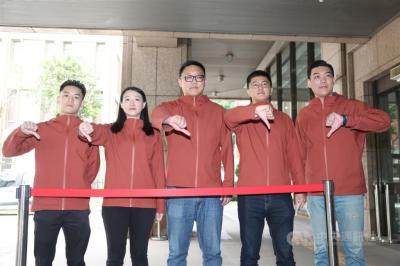The Department of Health’s Food and Drug Administration has set a limit of less than 2.5 parts per million (ppm) on the density of melamine that has dissolved in food after being put in melamine resin containers, sources said, adding that the new regulation might be enacted as soon as the end of this year.
At present, only the EU and China have food limits on the amount of melamine dissolved from melamine resin, with the EU’s standard set at below 30ppm.
Although Taiwan’s planned standard seems to be stricter than in other countries, Wu Chia-cheng (吳家誠), a chemistry professor at National Taiwan Normal University, said the health department “did not do the good deed all the way.”
Melamine resin is a plastic material made from melamine and formaldehyde through polymerization.
Wu said that melamine resin should not be used to make kitchen utensils and food containers in the first place, and especially not for children’s food containers.
“The quality of melamine resin containers is unstable,” Wu said.
He said the department’s method of examining dissolved melamine density is by using 4 percent acetic acid on containers made from melamine resin, then subjecting them to 95°C temperatures for 30 minutes.
However, there are substances in food other than acetic acid that can dissolve melamine, he said, adding that the containers used for testing are all new, while old resin containers with scratches could dissolve more melamine.
Lin Ja-liang (林杰樑), a clinical toxicology specialist at Chang Gung Memorial Hospital in New Taipei City (新北市), said that when melamine-resin containers are of poor quality, placed under high temperatures or come in contact with highly acidic foods, they might not only dissolve melamine, which can cause bladder stones, kidney stones and other kidney damage, but also formaldehyde, which could cause cancer.
Therefore, strict regulations are needed, he said.
Department officials said there were regulations on how much formaldehyde may be dissolved from melamine-resin containers, which does more harm to the body.
Because the health risks of melamine have become well known in recent years, with the WHO setting a tolerable daily intake limit, department officials said related standards were being planned in Taiwan after studying regulations in other countries.

Taiwan is stepping up plans to create self-sufficient supply chains for combat drones and increase foreign orders from the US to counter China’s numerical superiority, a defense official said on Saturday. Commenting on condition of anonymity, the official said the nation’s armed forces are in agreement with US Admiral Samuel Paparo’s assessment that Taiwan’s military must be prepared to turn the nation’s waters into a “hellscape” for the Chinese People’s Liberation Army (PLA). Paparo, the commander of the US Indo-Pacific Command, reiterated the concept during a Congressional hearing in Washington on Wednesday. He first coined the term in a security conference last

Prosecutors today declined to say who was questioned regarding alleged forgery on petitions to recall Democratic Progressive Party (DPP) legislators, after Chinese-language media earlier reported that members of the Chinese Nationalist Party (KMT) Youth League were brought in for questioning. The Ministry of Justice Investigation Bureau confirmed that two people had been questioned, but did not disclose any further information about the ongoing investigation. KMT Youth League members Lee Hsiao-liang (李孝亮) and Liu Szu-yin (劉思吟) — who are leading the effort to recall DPP caucus chief executive Rosalia Wu (吳思瑤) and Legislator Wu Pei-yi (吳沛憶) — both posted on Facebook saying: “I

Sung Chien-liang (宋建樑), who led efforts to recall Democratic Progressive Party (DPP) Legislator Lee Kun-cheng (李坤城), was released on bail of NT$80,000 today amid outcry over his decision to wear a Nazi armband to questioning the night before. Sung arrived at the New Taipei District Prosecutors’ Office for questioning in a recall petition forgery case last night wearing a red armband bearing a swastika, carrying a copy of Adolf Hitler’s Mein Kampf and giving a Nazi salute. Sung left the building at 1:15am without the armband and covering the book with his coat. Lee said today that this is a serious

The Ministry of Economic Affairs has fined Taobao NT$1.2 million (US$36,912) for advertisements that exceed its approved business scope, requiring the Chinese e-commerce platform to make corrections in the first half of this year or its license may be revoked. Lawmakers have called for stricter enforcement of Chinese e-commerce platforms and measures to prevent China from laundering its goods through Taiwan in response to US President Donald Trump’s heavy tariffs on China. The Legislative Yuan’s Finance Committee met today to discuss policies to prevent China from dumping goods in Taiwan, inviting government agencies to report. Democratic Progressive Party Legislator Kuo Kuo-wen (郭國文) said